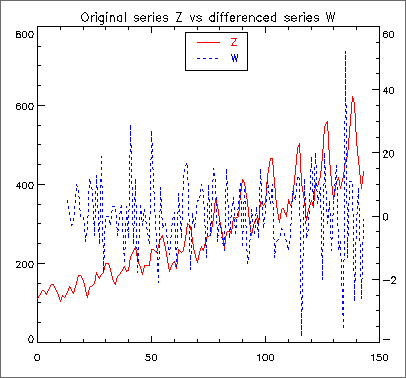SEASONAL_FIT
Estimates the optimum differencing for a non‑stationary time series using an autoregressive model, AR(p), to adjust the series for seasonality.
Required Arguments
Z — Vector containing the time series. (Input)
MAXLAG — Maximum lag allowed when fitting an AR(p) model,
1 <= MAXLAG <= NOBSZ/2. (Input)
IPERA — NDIFF by nipera matrix containing the seasonal differences to test. (Input)
Here, nipera = SIZE(IPERA, 2) must be greater than or equal to one.
All elements of IPERA must be greater than or equal to one.
W — Allocatable array which, on return, will contain the differenced series. (Output)
Optional Arguments
NOBSZ— Number of observations in time series Z. (Input)
Default: NOBSZ = SIZE(Z).
NDIFF — Number of differences to use. (Input)
NDIFF must be greater than or equal to one.
Default: NDIFF = SIZE(IPERA, 1).
IORDA — NDIFF by niorda matrix containing the possible orders of each difference given in IPERA. (Input)
Here, niorda = SIZE(IORDA, 2) must be greater than or equal to one.
All elements of IORDA must be non‑negative.
Default: IORDA is an NDIFF by 1 matrix, where IORDA (1:NDIFF, 1) =1.
IMISS — Missing value option. (Input)
Default: IMISS = 0
|
IMISS |
Action |
|
0 |
Include missing values in W. |
|
1 |
Exclude missing values from W. |
NOBSW — Number of observations in the differenced series W. (Output)
NOBSW = NOBSZ ‑ IMISS * NLOST
NLOST — Number of observations lost because of differencing the time series Z. (Output)
IOPT_PERA — Vector of length NDIFF containing the column from matrix IPERA which produced the differenced series represented in W. (Output)
IOPT_ORDA — Vector of length NDIFF containing the column from matrix IORDA which produced the differenced series represented in W. (Output)
NPAR — The optimum value for the autoregressive lag. (Output)
AIC — Akaike's Information Criterion (AIC) for the optimum seasonally adjusted model. (Output)
FORTRAN 90 Interface
Generic: CALL SEASONAL_FIT (Z, MAXLAG, IPERA, W [, …])
Specific: The specific interface names are S_SEASONAL_FIT and D_SEASONAL_FIT.
Description
Many time series contain seasonal trends and cycles that can be modeled by first differencing the series. For example, if the correlation is strong from one period to the next, the series might be differenced by a lag of 1. Instead of fitting a model to the series 

Routine SEASONAL_FIT does not center the original series. For every combination of columns in IPERA and IORDA, the series 

where s:= (s1,… ,sm) , d:= (d1,… ,dm) represent specific columns of arrays IPERA and IORDA respectively, and m = NDIFF.
This transformation of the series 


Example
Consider the Airline Data (Box, Jenkins and Reinsel 1994, p. 547) consisting of the monthly total number of international airline passengers from January 1949 through December 1960. Routine SEASONAL_FIT is used to compute the optimum seasonality representation of the adjusted series

where 

A differenced series with minimum AIC,

is in Differenced Series
USE GDATA_INT
USE SEASONAL_FIT_INT
IMPLICIT NONE
integer :: nout
integer, parameter :: nobs = 144, ndiff = 2, maxlag = 10
integer :: nlost, npar, i
integer :: NROW, NCOL
real, dimension(144,1) :: z
real :: aic
integer, dimension(2,2) :: ipera
integer :: nobsw
real, dimension(:), allocatable :: w
integer, dimension(ndiff) :: iopt_pera, iopt_orda
ipera(1,1) = 1; ipera(1,2) = 1
ipera(2,1) = 1; ipera(2,2) = 12
CALL GDATA (4, z, NROW, NCOL)
CALL seasonal_fit(z(:,1), maxlag, ipera, w, NDIFF = ndiff, NLOST = nlost, &
IOPT_PERA = iopt_pera, NOBSW = nobsw, &
IOPT_ORDA = iopt_orda, NPAR = npar, AIC = aic)
CALL UMACH(2,nout)
! WRITE (nout,*) "nlost =", nlost
! WRITE (nout,*) "iopt_pera = (", iopt_pera(1),",", iopt_pera(2), ")"
! WRITE (nout,*) "iopt_orda = (", iopt_orda(1),",", iopt_orda(2), ")"
! WRITE (nout,*) "Order of optimum AR process: ", npar
! WRITE (nout,*) "aic =", aic
! WRITE (nout,*) " "
! WRITE (nout,*) "Size of w:", nobsw
! WRITE (nout,*) "i z(i,1) w(i)"
! DO i=1,nobs
! WRITE (nout,*) i, z(i,1), w(i)
! END DO
IF (ALLOCATED(w)) DEALLOCATE(w)
END PROGRAM
Output


